
Strawberry U-Pick Orchards in Northern England in 2025, by county
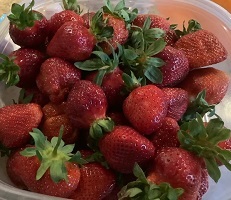 Below are the PYO orchards and farms for strawberries that we know of in this area. Not all areas have strawberries orchards or farms that are open to the public. If you know of any others, please tell us using the add a farm form!
Below are the PYO orchards and farms for strawberries that we know of in this area. Not all areas have strawberries orchards or farms that are open to the public. If you know of any others, please tell us using the add a farm form!
Remember to always check with the farm's own website or Facebook page before you go - or call or email them if they don't have a website or Facebook page. Conditions at the farms and crops can change literally overnight, so if you want to avoid a wasted trip out there - check with the farm directly before you go! If I cannot reach them, I DON'T GO!
PLEASE report closed farms, broken links and incorrect info using the "Report Corrections" form below.
Cumbria
- Park
House Farm - strawberries, Raspberries, Gooseberries, Red Currants, Black currants.
Park House Farm, Heversham, Milnthorpe, Cumbria, LA7 7EB. Phone: 01 539 563340. Email: capstick@kencomp.net. Open: 10:00am to 8:00pm, 7 days a week. Directions: We are on the right hand side of the A6, 6½ miles South of Kendal, just before Milnthorpe. Click here for our Facebook page . (UPDATED: July 12, 2015, JBS)
Durham
-
Lanchester
Fruit, Co. - Strawberries, Other Soft Fruit, Vegetables, Apple Juice, Geese and Ducks
Durham Road, Lanchester, Durham, DH7 0TQ. Phone: 01207- 528805. Open: 10am to 6pm, 7 days a week from June 20 until September 1. There haven't been any updates in a couple of years, just this news story. -
F W Elgey
- 2024 permanently closed, Apples, blackberries, broad beans, currants (red and black), peas, plums,
potatoes, raspberries (Spring, red), strawberries,
Lowfield Farm, Piercebridge, Darlington, DL2 3SU. Open: UPDATE: August 06, 2024: The owner tells me they are now permanently closed.
Northumberland
- Brocksbushes Fruit Farm - Blackberries, strawberries,
raspberries, gooseberries, blackcurrants, redcurrants, Tayberries,
pumpkins, squash, asparagus
Corbridge, Northumberland, NE43 7UB. Phone: 01434 633100. Open: Farm Shop: 9.30 am to 6 pm; Tea Room: 9.30 am to 5.30 pm. Directions: 16m W of Newcastle-upon-Tyne . N side of Styford rndbt - Jn of A68/A69 - 2 miles E of Corbridge. Entry is £1 per person (children under the height restriction are free) and a £1 refundable deposit for each Pick Your Own Basket you take into the picking fields. Whether you pick little and often or fill the freezer, you can select the best quality produce and make savings on buying from the Farm Shop. PYO farm, farm shop includes speciality & locally produced foods, plus soups and gourmet ready meals (fresh & frozen) made on the farm. Tea room with paved terrace opened 1995. Farm shop: Orchard fruits, soft fruits, fresh & frozen vegetables, speciality vegetables, fresh herbs, cheese, dairy produce, free range eggs, farm-produced meat, poultry, fresh fish, locally baked bread, preserves, cakes, pastries, honey, fruit juices. Facilities: Ample parking, children's play area, picnic area, tea room, plants & shrubs for sale, easy access for disabled, toilets, facilities for disabled. Tea room open all year. Home made frozen meals, logs and kindling sticks and garden furniture also available. Typical harvest dates are: Strawberries June - September; Gooseberries June - July; Raspberries July - October; Blackberries July - October; Tayberries July - October; Redcurrants July - August; Blackcurrants July - August; and Plums in September. (UPDATED: May 14, 2019, JBS) -
Oxford Farm - strawberries, raspberries, gooseberries, black
currants
Ancroft, Berwick upon Tweed, Northumberland, UK. Phone: 01289 387253. Farm selling home baking, preserves made on the premises, gift ware, vegetables. Quality tea-room/bistro. The farm shop has the same selection as the PYO, including specialty sauces, drinks, prepared dishes, fruit pies, cakes, meringues, honey, apple juice, cordials, local ice cream, jams.
Tyne and Wear
Strawberry Picking Tips, Recipes and Information
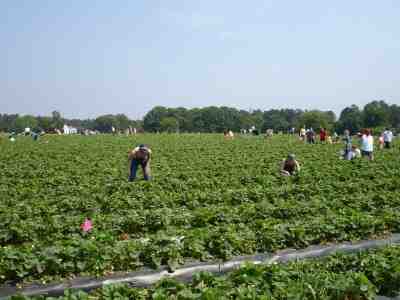
Strawberries typically begin from mid- May in the south and central England, and a couple of weeks later in the north and Scotland. They typically continue through June and into July. Beyond that, some farms plant later bearing varieties, day neutral varieties and "everbearers, so they may have strawberries to pick until frost. But to be sure of a good harvest, go early in the season, from mid May through June.
Of course, it highly depends upon microclimates (earlier in warmer western coastal areas) and the varieties planted by each farm. The timing, quality and quantity of the strawberry crop varies considerably, so always check with the farm's website or Facebook page - or even call them before you go to the farm.
Before you leave to go to the farm:
- Always call before you go to the farm - strawberries are affected by weather (both rain and cooler temperature) more than most crops. And when they are in season, a large turnout can pick a field clean before noon, so CALL first!
-
Leave
early. On weekends, then fields may be picked clean by NOON!
-
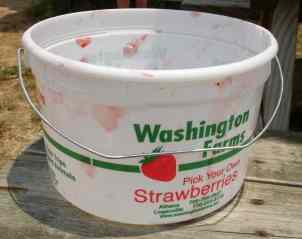 Most growers furnish picking containers designed
for strawberries, but they may charge you for them; be sure to call before you go to see if you need to bring
containers.
Most growers furnish picking containers designed
for strawberries, but they may charge you for them; be sure to call before you go to see if you need to bring
containers.
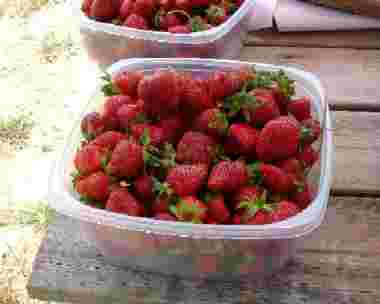 If you use your own containers, remember that heaping
strawberries more than 5 inches deep will bruise the lower berries.
Plastic
dishpans, metal oven pans with 3 inch tall sides
If you use your own containers, remember that heaping
strawberries more than 5 inches deep will bruise the lower berries.
Plastic
dishpans, metal oven pans with 3 inch tall sides and large pots make good
containers. I like the Glad storage containers like the one at right.
and large pots make good
containers. I like the Glad storage containers like the one at right. -
Bring something to drink and a few snacks; you'd be surprised how you can
work up a thirst and appetite! And don't forget hats and sunscreen for the
sun. Bugs usually aren't a problem, but some deet might be good to bring
along if it has been rainy.
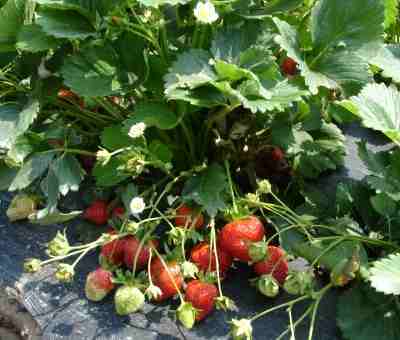
Tips on How to Pick Strawberries
- Grasp the stem just above the berry between the forefinger and the thumbnail and pull with a slight twisting motion.
- With the stem broken about one-half inch from
the berry, allow it to roll into the palm of your hand.
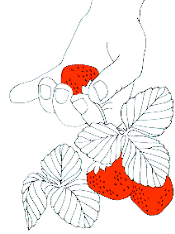
- Repeat these operations using both hands until each holds 3 or 4 berries.
- Carefully place - don't throw - the fruit into your containers. Repeat the picking process with both hands.
- Don't overfill your containers or try to pack the berries down.
General Picking Tips
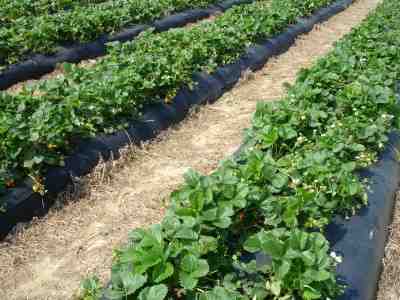 Whether you pick strawberries from your garden or at
a Pick-Your-Own farm, here are a few tips to keep in mind:
Whether you pick strawberries from your garden or at
a Pick-Your-Own farm, here are a few tips to keep in mind:
-
Be careful that your feet and knees do not
damage plants or fruit in or along the edge of the row.
- Pick only the berries that are fully red. Part
the leaves with your hands to look for hidden berries ready for harvest.
- To help the farmers, also remove from the plants
berries showing rot, sunburn, insect injury or other defects and place them
between the rows behind you. If they are left in the plants, the rot will
quickly spread to other berries.
- Berries to be used immediately may be picked any
time, but if you plan to hold the fruit for a few days, try to pick in the
early morning or on cool, cloudy days. Berries picked during the heat of the
day become soft, are easily bruised and will not keep well.
- Avoid placing the picked berries in the sunshine any
longer than necessary. It is better to put them in the shade of a tree or
shed than in the car trunk or on the car seat. Cool them as soon as possible
after picking. Strawberries may be kept fresh in the refrigerator for two or three, depending upon the initial quality of the berry. After a few
days in storage, however, the fruit loses its bright colour and fresh flavor
and tends to shrivel.
- For interesting and fun strawberry facts and trivia from the California Strawberry Commission, click here!
When you get home
- DON'T wash the berries until you are ready to use them. Washing makes them more prone to spoiling.
- Pour them out into shallow pans and remove any mushed, soft or rotting berries
- Put a couple of days supply into the fridge, wash and cut the caps (green tops) off the others and freeze them up! (Unless you're going to make jam right away) See this page about how to freeze strawberries.
- If you like the strawberries you picked, ask the farm what variety they planted, and not the weather conditions the week or two before. The flavor of a strawberry is affected by the variety, the weather and the degree of ripeness when picked.
- Now, get ready to make strawberry jam. It is VERY easy - especially with our free strawberry jam instructions - they're illustrated and easy.
Strawberry Recipes, Canning and Freezing Strawberries
- How to freeze strawberries!
- Strawberry jam (with pectin) (uses less sugar or honey and less cooking)
- Strawberry jam (without pectin) (requires much more sugar and cooking)
- Strawberry (and other berry) jams without sugar
- Strawberry jelly
- Strawberry-rhubarb jam!
- Homemade strawberry ice cream (regular, low fat, nonfat, low sugar, vanilla and even gelato)
- Canning strawberries
- Make gourmet chocolate-covered strawberries
- How to make fruit juice - strawberry and other berries
- Strawberry pie filling
- Strawberry pie
- Easy Rhubarb-Strawberry pie
- Fig-strawberry jam
- Fig-strawberry jam, made with Jello gelatin
Strawberry Facts, Measurements and Tips
-
Picking the best strawberries:
Select firm, fully red berries. Strawberries DO NOT continue ripen after
they are picked! In the photo, only the berry on
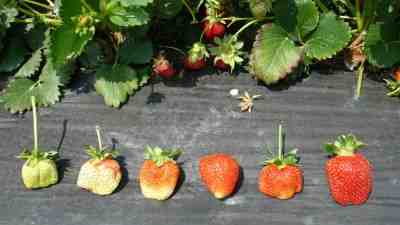 the far right is
completely ripe.
the far right is
completely ripe. - Strawberry festivals: Most areas that grow strawberries have a strawberry festival, at which you can taste all kinds of fresh strawberry foods, pies, jams, cakes - and most commonly, fresh strawberry shortcake. To find out where and when there is one near you, see this page for a list of strawberry festivals in the UK!
- Strawberries measurements: government agriculture
websites tell us that
1 quart = 2 pints = 4 cups and is about the same as 1 liter and
1 quart of fresh strawberries weighs 1 lbs to 1.25 lbs (or 450 to 600 g). Of course, the weight varies on variety and weather conditions.
1 quart is normally enough for 4 servings, although I'll admit my son can eat 1 pint by himself! - How much to pick? In general, 1 quart of fresh, whole, just-picked strawberries = approximately 3.5 cups (828 g) hulled, whole berries. In other words, removing the caps/hulls and the occasional mushy berry means you lose 1/4 cup to 1/2 (60 g to 120 g))(it depends how much fruit you remove with the hull) or about 7 to 12% of every quart you pick.
- One cup of strawberries contains only about 50 calories
- U-pick strawberries are much healthier than store-bought. Consumer reports says store bought strawberries have so many pesticide and fungicide residues on they, that they don't recommend you eat them at all!
- U-pick strawberry farms typically sell berries by the pound. 1 lbs (450 g) of fresh strawberries is about 2/3 of a quart/liter.
- It takes about 10 to 15 minutes to pick a quart, if the berries are reasonably plentiful
- The strawberry plant adapts to wide variety of soil conditions, but does not tolerate drought well, and the berries quickly rot if the weather is rainy. For this reason, the plants are usually grown on raised beds through plastic mulch!
- Cultivation of strawberries began in Europe in the 1300's, but the berry only became very popular in the early 1900's in California.
- Do the math and be careful not to over-purchase as strawberries quickly mold when left at room temperature, and only last a couple of days in the refrigerator.
- You can easily freeze berries that you cannot use right away - just
wash, cut the hulls off and pop them into a ziplock bag, removing as much
air as possible. Those vacuum food sealers REALLY do a good job of
this! The berries will keep for many months frozen without air.

- Want to grow your own strawberries? Here's an article about how to: Strawberries are an Excellent Fruit for the Home Garden, HYG-1424-98!
- See this page for many more fun and interesting strawberry facts, nutritional information and trivia
Other weird strawberry facts
- Strawberries are the only fruit with seeds on the outside.
- Strawberries were originally called strewberries because the fruit was 'strewn' amongst the leaves of the plant.
More conversions
1 pint (2 cups) of fresh whole strawberries
- = about 8 oz (1/2 lb, 225 g) of strawberries
- = 2.25 cups of sliced strawberries
- = 1 cup pureed strawberries
- = 12-14 large strawberries
2 quarts of fresh strawberries are needed for a 9" pie
A 10 oz / 280gpackage of frozen berries is about the same as 1 cup of sliced fresh strawberries
| Strawberries - Average 2024 (most recent ) retail price per pound and per cup equivalent, | ||||||
| Form | Average retail price | Preparation yield factor | Size of a cup equivalent | Unit | Average price per cup equivalent | |
| Fresh *1 | per kilogram | 0.94 | 0.320 | Kg | ||
| Frozen *2 | per kilogram | 1 | 0.331 | Kg | ||
| 1 - Includes regular strawberries. Excludes jumbo and long-stemmed varieties. The Standard Reference (SR) reports that inedible caps and stems account for 6 percent of the retail weight, implying a preparation yield of 94 percent, when strawberries are eaten raw. | ||||||
| 2 - Excludes strawberries with added sugar or other sweeteners. Includes unsweetened strawberries. Consumers are assumed to eat the berries in frozen form without further preparation. | ||||||
| Source: USDA, Economic Research Service calculations from 2020 Circana (formerly Information Resources, Inc. [IRI]) OmniMarket Core Outlets (formerly InfoScan) data; the USDA National Nutrient Database for Standard Reference (SR), Legacy Release; and the Food Patterns Equivalents Database (FPED) 2017�18 as well as the FPED's accompanying Methodology and User Guide. | ||||||
References:
Other Local Farm Products (Honey, Horses, Milk, Meat, Eggs, Etc.)
(NOT pick-your-own,
unless they are also listed above)
Farmshops, Farmer's Markets and Roadside Stands, Etc. (NOT pick-your-own, unless they are also listed above)
Click here for farmshops in this area.
Local Honey Sources:
Meats, Milk and Eggs:
Farm Venues for Weddings, Events, Activities, Parties and Meetings:
Horse Rides and More:
Farm Bed And Breakfasts
Maple Syrup Farms and Sugarworks: